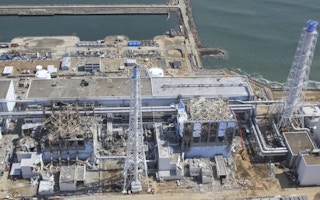The Fukushima nuclear disaster was the result of “man-made” failures before and after last year’s earthquake, according to a report from an independent parliamentary investigation.
The breakdowns involved regulators working with the plant operator Tokyo Electric Power to avoid implementing safety measures as well as a government lacking commitment to protect the public, the Fukushima Nuclear Accident Independent Investigation Commission said in the report.
The March 11 accident, which set off a wave of reactor safety investigations around the world, “cannot be regarded as a natural disaster,” the commission’s chairman, Tokyo University professor emeritus Kiyoshi Kurokawa, wrote in the report released yesterday in Tokyo. It “could and should have been foreseen and prevented. And its effects could have been mitigated by a more effective human response.”
The report dealt the harshest critique yet to Tokyo Electric and the government. The findings couldn’t rule out the possibility that the magnitude-9 earthquake damaged the Fukushima Dai-Ichi No. 1 reactor and safety equipment. This is a departure from other reports that concluded the reactors withstood the earthquake, only to be disabled when the ensuing tsunami slammed into the plant.
This finding may have implications for all Japan’s atomic plant operators if it leads to tougher earthquake-resistance standards. The operators reported combined losses of 1.6 trillion yen ($20 billion) in the year ended March owing to safety shutdowns of the country’s 50 reactors and higher fuel bills when they started up gas and oil-fired plants.
Earthquake’s effect disputed
If the Fukushima reactor had already been crippled by the quake when the tsunami hit, it would force regulators to reconsider the seismic criteria that all Japan’s plants need to follow, their so-called design basis, said Najmedin Meshkati, a professor of civil engineering at the University of Southern California who has researched nuclear safety in Japan.
“This finding basically puts into question some of the design basis assumptions that we have,” Meshkati said in a phone interview. “If this reactor got some damage because of the earthquake, we really need to go back and revisit some of our assumptions that we have for the design basis of other reactors.”
Two reactors run by Kansai Electric Power won approval to restart this month, despite protests outside the prime minister’s office in Tokyo that drew as many as 20,000 people on June 29, Kyodo News reported, citing police estimates. A Mainichi newspaper poll on June 4 showed as many as 71 percent of Japanese opposed the restarts.
Ignorance, arrogance
The report said the commission found evidence of “collusion” between Tokyo Electric and regulator, the Nuclear and Industrial Safety Agency, to avoid implementing new safety regulations.
Tokyo Electric also exploited its cozy relationship with regulators to take the teeth out of regulations. “Across the board, the Commission found ignorance and arrogance unforgivable for anyone or any organization that deals with nuclear power,” the report said.
The six-month independent investigation, the first of its kind with wide-ranging subpoena powers in Japan’s constitutional history, held public hearings with former Prime Minister Naoto Kan and Tokyo Electric’s ex-President Masataka Shimizu, who gave conflicting accounts of the disaster response.
Kan said he agreed with the finding that the disaster was man-made, though he differed with the reports findings on the government response, according to a posting on his official blog last night.
Contrary finding
Three other investigations led by the government, the utility and a private foundation said in earlier reports that they found no evidence of major damage to reactor buildings and equipment at the Fukushima Dai-Ichi nuclear station from last year’s quake. They concluded the plant was swamped by a 13-meter (43 foot) tsunami that followed the quake, knocking out backup power generation and causing the meltdown of three reactors.
Radiation fallout from the reactors forced the evacuation of about 160,000 people and left land in the area uninhabitable for decades.
The Commission has 10 members, including Kurokawa. The group comprises a seismologist and a former nuclear engineer who has warned of safety risks at atomic plants and criticized the government’s nuclear energy policy.
Lacking information
Mutsuhito Tanaka, a former nuclear equipment engineer at a unit of Hitachi and a member of the commission, and Hiroaki Koide, an assistant professor at Kyoto University’s Research Reactor Institute, are among those who have said the quake may have caused more damage to the Fukushima plant than so far reported.
The commission’s report said the Fukushima situation was worsened by government mismanagement. The utility known as Tepco can’t use the government as a scapegoat as its own information disclosure through the disaster was lacking, the report said.
Japan’s parliament in December appointed Kurokawa, a doctor of medicine, to head the investigative panel.
Kurokawa clashed with the government when Prime Minister Yoshihiko Noda and his cabinet approved a bill on January 31 to create a new nuclear regulatory agency.
“It is very hard to understand how the cabinet decision has been made” before the panel finishes its investigation, Kurokawa said in the statement. One of the panel’s missions is to make recommendations including the reexamination of Japan’s nuclear policy and administrative organizations to prevent a future atomic accident, Kurokawa said.
‘Regulatory capture’
After amending the bill`on the new regulator to give it more independence, the parliament passed the legislation on June 20. The new watchdog to be established as early as September, will replace the Nuclear Industrial Safety Agency and the Nuclear Safety Commission, two regulatory bodies criticized for their poor handling of the Fukushima disaster.
The Kurokawa report says the collusion between nuclear regulators and atomic plant operators led to what it called “regulatory capture,” a state in which oversight of the nuclear industry effectively ended.
“Outside Japan, some people will try to misuse this report to say it can’t happen here. The fact is that it can,” Arnie Gundersen, a US-based former nuclear engineer and licensed reactor operator, said in an e-mail response.
“Here in the US, the industry basically forced out Gregory Jaczko as chair of the










